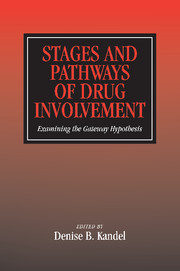Book contents
- Frontmatter
- Contents
- List of Contributors
- Foreword
- Preface
- Part I Overview
- Part II Recent Substantive Findings: What Do We Know About Stages of Drug Use, Risks, and Protective Factors?
- Part III Impact of Prevention Interventions: A Test of the Progression Hypothesis
- 6 Preventing the Onset and Developmental Progression of Adolescent Drug Use: Implications for the Gateway Hypothesis
- 7 The Gateway Theory Applied to Prevention
- 8 Intervention Effects on Adolescent Drug Use and Critical Influences on the Development of Problem Behavior
- Part IV Methodological Issues and Approaches: Advantages and Limitations of Alternate Methods
- Part V Animal Models and Biological Processes: Implications for Drug Progression
- Part VI Conclusion
- Index
7 - The Gateway Theory Applied to Prevention
Published online by Cambridge University Press: 25 July 2009
- Frontmatter
- Contents
- List of Contributors
- Foreword
- Preface
- Part I Overview
- Part II Recent Substantive Findings: What Do We Know About Stages of Drug Use, Risks, and Protective Factors?
- Part III Impact of Prevention Interventions: A Test of the Progression Hypothesis
- 6 Preventing the Onset and Developmental Progression of Adolescent Drug Use: Implications for the Gateway Hypothesis
- 7 The Gateway Theory Applied to Prevention
- 8 Intervention Effects on Adolescent Drug Use and Critical Influences on the Development of Problem Behavior
- Part IV Methodological Issues and Approaches: Advantages and Limitations of Alternate Methods
- Part V Animal Models and Biological Processes: Implications for Drug Progression
- Part VI Conclusion
- Index
Summary
After several years of no change or increase, adolescent drug use in the United States has declined slightly (Johnston, O'Malley, & Bachman, 1999). However, use of tobacco, alcohol, and marijuana, the drugs referred to as Gateway drugs, remains at high levels. Gateway or steppingstone theory posits that early use of Gateway drugs (tobacco, alcohol, marijuana) predisposes adolescents to risk of later use of other, illicit substances, including amphetamines (Marcos & Bahr, 1995; Torabi, Bailey, & Majd-Jabbari, 1993; Yamaguchi & Kandel, 1984). Gateway drug use may account for 39% or more of the variation in adolescent amphetamine use (Marcos & Bahr, 1995).
Theoretical Questions in Applying Gateway Theory to Prevention
Gateway theory has been criticized (DeWit, Offord, & Wong, 1997); however, at least three factors are driving reexamination of its utility for understanding the development and prevention of adolescent drug use. First is the question of whether certain drugs act as a gateway because of their social modeling influence, addictive potential, or psychobiological novelty effect (Bardo, Donohew, & Harrington, 1996; Lindsay & Rainey, 1997; Torabi et al., 1993). The implication is that if other drugs served any of these purposes for young adolescents, they would replace tobacco, alcohol, and marijuana as Gateway drugs.
- Type
- Chapter
- Information
- Stages and Pathways of Drug InvolvementExamining the Gateway Hypothesis, pp. 139 - 157Publisher: Cambridge University PressPrint publication year: 2002
- 6
- Cited by



